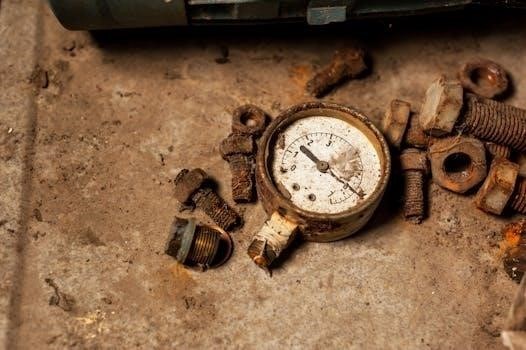Understanding Your Pressure Washer Manual
Your pressure washer manual is essential for safe and effective use. It contains crucial information such as operating instructions, maintenance schedules, and safety precautions. Familiarize yourself with it before using your new machine. It provides guidance on choosing the right nozzle and using accessories, ensuring optimal performance.
A pressure washer manual serves as the primary guide for operating, maintaining, and troubleshooting your specific pressure washer model. These manuals are not generic; they are tailored to each machine, encompassing the unique features and specifications of your device. They typically include detailed diagrams of the unit, highlighting the various parts and components. Understanding the manual before first use is crucial for safe and efficient operation. Furthermore, pressure washer manuals often include manufacturer-specific advice on cleaning techniques and best practices.
The manual also provides essential information about the pressure washer’s performance capabilities, such as the pressure output in pounds per square inch (psi) and the flow rate in gallons per minute (gpm). These are critical parameters to understand, as they determine the type of cleaning jobs the machine can effectively handle. Manuals often specify types of cleaning solutions that are compatible with the pressure washer, ensuring you avoid damage to the unit. They also contain information about the correct storage procedures to maintain the machine’s longevity. In addition, you’ll find essential information about connecting to a water source, and the electrical requirements for the device. This comprehensive guide is your first stop for any question.

Safety Precautions and Warnings
Pressure washer manuals emphasize safety, as these powerful machines can cause injury if mishandled. Always read and understand all warnings before operating. Never direct the high-pressure spray at people or animals; the force of the water can cause serious harm. Wear appropriate safety gear, including eye protection and closed-toe shoes, to protect against debris and potential injuries. Ensure the area you’re cleaning is clear of bystanders, especially children, who should not operate the pressure washer. Avoid using the machine while fatigued or under the influence of alcohol or drugs, as this impairs judgment and reaction time.
When using an electric pressure washer, ensure the power cord is properly grounded and avoid using extension cords if possible. If you must use an extension, ensure it is rated for outdoor use and can handle the required amperage. For gas-powered models, never refuel while the engine is running or hot. Only operate gas pressure washers in well-ventilated areas to prevent carbon monoxide poisoning. Be extremely careful if you must use the pressure washer from a ladder, scaffolding, or any other similar location. Always maintain firm grip and be aware of your surroundings. The manual will detail these and other critical safety precautions to avoid accidents and ensure safe operation.
Operating Instructions⁚ Step-by-Step Guide
The manual provides a detailed step-by-step guide for operating your pressure washer. Before starting, connect the garden hose to the water inlet and ensure the water supply is turned on. For electric models, plug the power cord into a grounded outlet. For gas models, fill the fuel tank with the appropriate gasoline and check the engine oil level. Squeeze the trigger on the spray gun to release any air from the system. Select the correct nozzle for your cleaning task; the manual will specify different nozzles for various purposes, like wide spray for rinsing and narrow spray for tough stains.
Turn on the pressure washer, and begin spraying at a safe distance to avoid surface damage. Maintain a steady grip on the spray gun and use smooth, overlapping strokes. The manual will guide you on applying cleaning chemicals, if desired, through the detergent tank. Follow the manual’s instructions for adjusting the pressure to suit the surface you’re cleaning. When finished, turn off the machine, disconnect the water supply, and release any remaining pressure from the hose. Always refer to your specific manual for precise instructions tailored to your model.
Maintenance Procedures for Longevity
Regular maintenance is crucial for the longevity of your pressure washer, as outlined in your manual. Always check the pump oil level before first use and change it after the initial 50 hours, then every 3 months or 300 hours. Consult your manual for the correct oil type. For gas pressure washers, ensure regular checks on the engine oil and air filter, replacing as needed, per the manual’s guidelines. Clean the nozzles regularly to prevent clogs, using the provided nozzle cleaning tools or a small pin. Inspect hoses and connections for any signs of wear, leaks, or damage, replacing them immediately if found.
Routinely flush the machine with clean water after each use to remove any remaining detergent or debris. Store your pressure washer in a dry, covered area to protect it from the elements, following the storage instructions in the manual. Before storing for extended periods, prepare the pressure washer according to the manual’s instructions, which may include draining the pump and adding a pump protector. Adhering to these maintenance steps, as detailed in your manual, will keep your pressure washer running smoothly and reliably for years.
Troubleshooting Common Issues
Consult your pressure washer manual first when encountering problems. A common issue is a lack of pressure, often caused by a clogged nozzle, which can be resolved by cleaning it. Check for kinks or leaks in the hose; these can also reduce pressure. If the pump isn’t priming, ensure the water supply is adequate and there are no blockages. For gas-powered models, problems starting may indicate fuel issues or a spark plug needing attention, as detailed in your manual.

If the machine pulsates or vibrates excessively, it might signal air in the system, which can be addressed by releasing the trigger and letting water flow through. Unusual noises often warrant further examination, possibly indicating internal wear. If your pressure washer is not dispensing detergent properly, check the detergent tank and siphon tube for blockages or damage. Refer to the troubleshooting section of your manual for specific guidance on diagnosing and resolving these and other issues. Always turn off the machine and disconnect it from power before attempting any repairs.
Types of Pressure Washers⁚ Electric vs. Gas
Pressure washers come in two main types⁚ electric and gas. Electric models are typically more lightweight and easier to maintain, making them ideal for residential use, like cleaning decks and cars. They require a nearby power outlet and are generally quieter. Gas pressure washers, on the other hand, are more powerful and portable, suitable for heavy-duty tasks such as cleaning large driveways or removing stubborn stains. These models require fuel, typically gasoline, and may produce more noise and emissions.
The choice between electric and gas depends on the cleaning tasks and user preference. Electric units are better for smaller areas and routine cleaning, whereas gas models offer greater versatility and power for larger jobs. Both types have their advantages and limitations, so carefully consider your needs and the information in your manual before deciding. Your manual will provide specific guidelines for operation and maintenance based on the type of pressure washer you have. It’s important to understand the differences to ensure optimal use.

Choosing the Right Nozzle and Accessories
Selecting the correct nozzle and accessories is crucial for effective and safe pressure washing. Nozzles vary in spray pattern and pressure, each designed for specific cleaning tasks. A wide-angle nozzle is suitable for general cleaning, while a narrow, focused nozzle is better for stubborn stains. Some nozzles even have adjustable spray patterns. Using the wrong nozzle can damage surfaces or result in inefficient cleaning. Always refer to your pressure washer manual for guidance on selecting and using the correct nozzle for your task.
Accessories like extension wands, brushes, and surface cleaners enhance versatility. Extension wands allow you to reach higher areas safely, while brushes provide gentle scrubbing action. Surface cleaners are designed for cleaning large flat areas like patios and driveways. Your manual will detail the specific accessories compatible with your pressure washer and how to use them effectively. Understanding these tools will enable you to achieve the best cleaning results and protect the surfaces you are cleaning. Always follow the instructions in your manual.
Cleaning Techniques and Best Practices
Effective pressure washing requires employing the right techniques. Start by testing the pressure on an inconspicuous area to avoid damage. Hold the nozzle at a consistent distance from the surface and use smooth, overlapping strokes. Avoid focusing the spray in one spot for too long. For stubborn stains, use a more focused nozzle, but with caution. When cleaning vertical surfaces, work from top to bottom to prevent streaking. It is best to start with lower psi and increase gradually to achieve the best cleaning result.
Always consult your pressure washer manual for specific guidelines. Using the correct cleaning solutions is also vital. Ensure that any cleaning formula is safe for your unit. Pre-soaking surfaces with a cleaning solution can be effective for difficult dirt. After cleaning, rinse thoroughly with clean water. Practice makes perfect, so with time you will get better at using a pressure washer. Following these best practices will make your cleaning more efficient and safer, protecting both you and the surfaces.
Storage and Handling of Your Pressure Washer
Proper storage and handling are crucial for extending the life of your pressure washer. Before storing, always disconnect the water and power supply. Release any remaining pressure in the system by squeezing the spray gun trigger. Drain all water from the pump and hoses to prevent freezing in cold weather. Store your pressure washer in a dry, covered area away from extreme temperatures and direct sunlight.

Do not store your machine on its side, always keep it in an upright position. Ensure that the hoses are properly coiled and not kinked to prevent damage. If your pressure washer has a fuel tank, make sure the fuel is drained for long-term storage or use a fuel stabilizer. When handling, avoid dropping or bumping it to prevent damage to internal components. Remember to refer to your manual for any specific storage instructions for your particular model. These storage and handling practices will help ensure your pressure washer remains in good working order for years to come.



